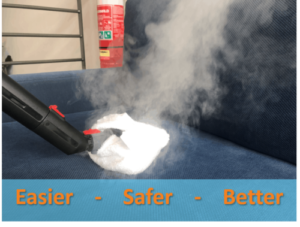Combating Biofilms

What Are Biofilms?
The definition of biofilms are “a thin but robust layer of mucilage adhering to a solid surface and containing a community of bacteria and other microorganisms”. Biofilms act as a defence mechanism for microbes providing a barrier of slime encasing and protecting the microbes. A biofilm can be found on any given surface or in water. Microorganisms that form biofilms include bacteria, fungi and protists. Different biofilms grow at different rates, some can even be visible to the eye. A common example is dental plaque, a slimy build-up of bacteria that forms on the surfaces of teeth, which can be visible within a day.[1]

What Issues Do Biofilms Present For Cleaning?
Biofilms cause a number of issues for infection prevention and control teams in health care settings.[2] Due to their defensive nature biofilms can be very difficult to remove. Traditional cleaning methods are ineffective in practice at removing biofilms. Two major hurdles for these methods include:
Mechanical action – Scrubbing surfaces is hard work and the right tool isn’t always at hand. Effective mechanical action can lead to fatigue and injuries in workers. Even the most effective scrubbing may not be sufficient as one study[3] found that scrubbing may just realign the biofilm in the direction of the mechanical action.
Effective products and exposure time – Most chemicals which have been tested against biofilms have complex application methods which must be followed for them to be effective. This typically includes cleaning with an effective detergent, rinsing, applying the product at the correct dilution for the correct duration (up to 10 minutes) if a surface dries within this period the product must be reapplied for the duration of the required dwell time. Any number of human errors in these steps can result in the product being ineffective against the biofilm and microbe behind it.
If biofilms are not cleaned properly the remaining microbes can spread quickly as traditional cleaning methods do not focus on the removal of microbes from the surfaces. The surviving bacteria is left a food source of dead bacteria to feed on and repopulate.


The Need For A New Method
Surface transmission is a major concern in many industries including schools, health care and food processing facilities. We know that Chemical disinfectants are frequently used to reduce contamination, but many pose significant risk to humans, surfaces, and the environment, and all must be properly applied in strict accordance with the label instructions to be effective.[4] This is one of the many reasons of this that health organisations such as the NHS[5] and Monash Health[6] have started to look for new safer methods to assist in the fight against biofilms.
Combating Biofilms with Dry Steam
Steam has been proven effective against biofilms both in the lab and in practice. Common biofilms have been found ineffective against the temperature produced by dry steam cleaning machines. The pressure generated by the steam machine reduces the operators need of any mechanical actions resulting in an easier, simpler and more effective clean. These results have been reproduced in health care environments throughout the world. Typical methods of steam cleaning also focus on the removal of microbes from the environment, this means the food source is removed from future microbes.
Join the future of cleaning,
with Steam Australia.
Get in touch today on 1300 79 50 50 or [email protected]
[1] Vidyasagar, A. What are biofilms? Live Science (2016) https://www.livescience.com/57295-biofilms.html
[2] Song, L., Wu, J. Xi, C. Biofilms on environmental surfaces: Evaluation of the disinfection efficacy of a novel steam vapor system. American Journal of Infection Control v40:10, 926-930 (2012) https://doi.org/10.1016/j.ajic.2011.11.013
[3] Tanner, B. Reduction in infection risk through treatment of microbially contaminated surfaces with a novel, portable, saturated steam vapor disinfection system. American Journal of Infection Control, v37:1, 20-27 (2009) https://doi.org/10.1016/j.ajic.2008.03.008
[4] Tanner, B. Reduction in infection risk through treatment of microbially contaminated surfaces with a novel, portable, saturated steam vapor disinfection system. American Journal of Infection Control, v37:1, 20-27 (2009) https://doi.org/10.1016/j.ajic.2008.03.008
[5] An integrated approach to hospital cleaning: microfibre cloth and steam cleaning technology. Department of Health (2008) https://www.england.nhs.uk/publication/an-integrated-approach-to-hospital-cleaning-microfibre-cloth-and-steam-cleaning-technology/
[6] Gillespie E, ‘Cleaning without chemicals at Monash Health, Case study: Conversation Series #2’ (2016) https://www2.health.vic.gov.au/about/publications/ResearchAndReports/cleaning-without-chemicals-at-monash-health-case-study
[7] String, G., Domini, M., Mirindi, P. et al. Efficacy of locally-available cleaning methods in removing biofilms from taps and surfaces of household water storage containers. npj Clean Water 3, 13 (2020). https://doi.org/10.1038/s41545-020-0061-y











